If you have a Viair compressor you know it’s a quality piece of equipment but you may have also noticed some areas of improvement. About 2 ½ years ago I upgraded my compressor setup with a few items and it has made a great improvement in usability! Several people have asked about my kit and so I figured I’d write a post about it.
I have the Viair 400P-RV Automatic Air Compressor for airing my tires back up at the end of a day on the trail. I chose the 400P-RV Automatic for a few reasons. First of all it had the CFM flow rating that I wanted to fill my tires back up in a timely manner. Secondly it was significantly cheaper than the ARB equivalent while also likely being much higher quality than the much cheaper Smittybilt and MV-50 that are so popular. I also liked that the bag had 2 hoses so that I could easily fill a friends tires if needed without moving the compressor and re-hooking it up to their vehicle. Finally, I liked that the automatic cut-off built into the compressor meant that I could hard mount it down the road with a tank and it would automatically shut off when the tank pressure was achieved.
While the compressor has not failed to meet my needs on any of these fronts I do have two major issues with the equipment as it comes out of the box. First of all the unit creates so much heat that it heats up the quick disconnect where the hose attaches. It heats it so much that you cannot grab the quick disconnect bare handed to remove the hose after filling up 4 tires without getting burned! The final straw was when a hose I was using burst just beside the quick disconnect from what I have to assume was a heat related failure.
The second issue is that the hoses that come with the compressor are cheap nylon hoses. Fine for general use but when you use them as often as I do, all year long as I do, you find that the nylon hoses are stiff and get dangerously stiff in cool weather. Once while airing up my tires in 10 degree weather I needed both hoses (supposedly a 60ft reach) just to get to my back tires because the nylon hoses were that stiff. This was also arguably very unsafe.
So I set out to improve my setup to meet my needs better. See the Parts List at the end of this post for links to all the parts!
Compressor Improvements
In the future I may try to keep the compressor cooler but in the meantime I just wanted to move the connector that the hose connects to further from the heat of the compressor. I figured I could achieve this with a heavier duty rubber hose (rated to 250 psi working pressure) attached directly to the compressor. This hose I also hoped would stand the heat better than polyurethane or nylon. To keep the hose from coming straight off the end of the compressor and no longer fitting in my bag I added a swiveling pneumatic adapter to turn the hose (rated to 300psi working pressure*) then attached the hose to the adapter. On the end I attached a Dixon Push-to-Connect Male fitting (with female threads). This way the entire hose acts as a thermal insulator. The connector I grab never gets hot. I wrap the hose around the compressor in one loose loop to make it more manageable.
*Be careful when selecting a swiveling adapter. Many similar looking adapters were only rated to 150psi which is below the maximum operating pressure of this compressor.
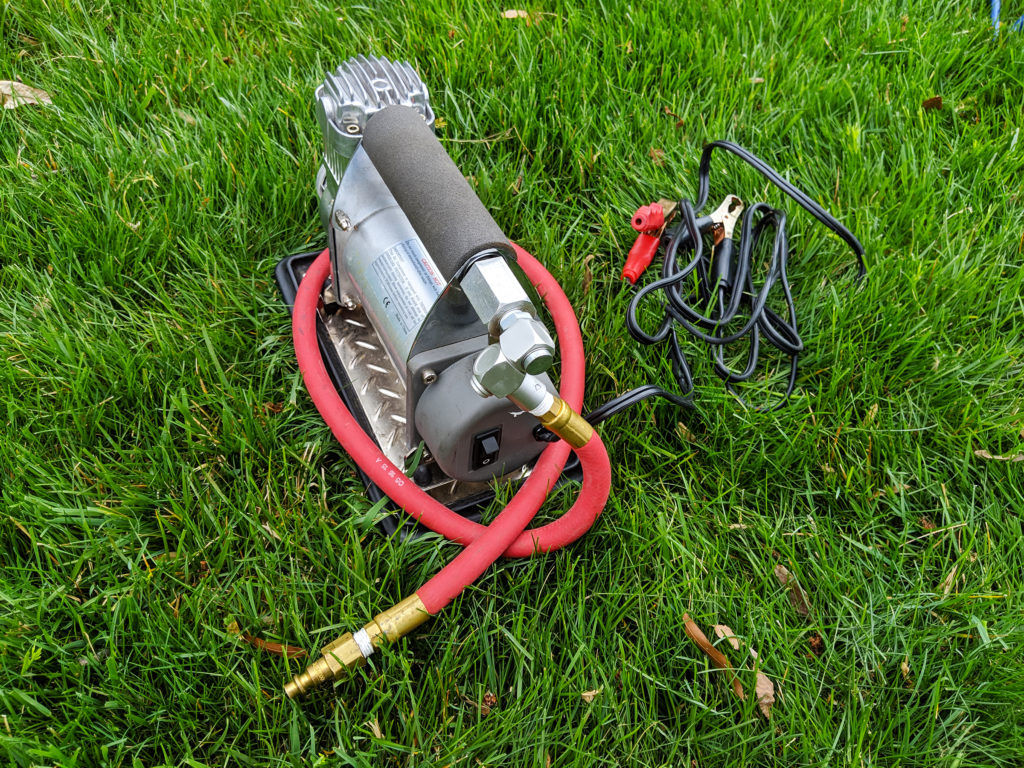
Hose Improvements
The two hoses also needed upgraded. I suggest upgrading to a polyurethane hose because it should safely work to -50F according to the manufacturer of the hose I purchased. I think I remember you’re not supposed to use the nylon ones below 40F because they can get brittle.** I looked long and hard for a polyurethane hose that would be similar in length to the original hoses but also easily fit into the pockets of the Viair bag. Additionally they needed to be rated to the same operating pressure, or higher, as the compressor which is 155psi.***
Once I had a hose selected I needed to get ends to make them work the same as the originals. One of the original hoses had a female quick disconnect on each end. This hose connects between the compressor and the inflator. The other hose had one male and one female quick disconnect. This hose is optionally used between the first hose and the inflator. I selected the appropriate Dixon fittings to attach to my 1/4in NPT threads.
**The picture on the website for the Viair 400P-RV Automatic shows black hoses, mine were yellow. They may have upgraded the kit hoses.
***The max operating pressure of the compressor is technically 155psi +/- 5% which means the shut off switch can actually kill the pressure up to 162.75psi. Considering the 3x Factor of Safety on the hose burst rating of 160 x 3 = 480 psi I am comfortable using this hose with my compressor but you need to make that decision for you.
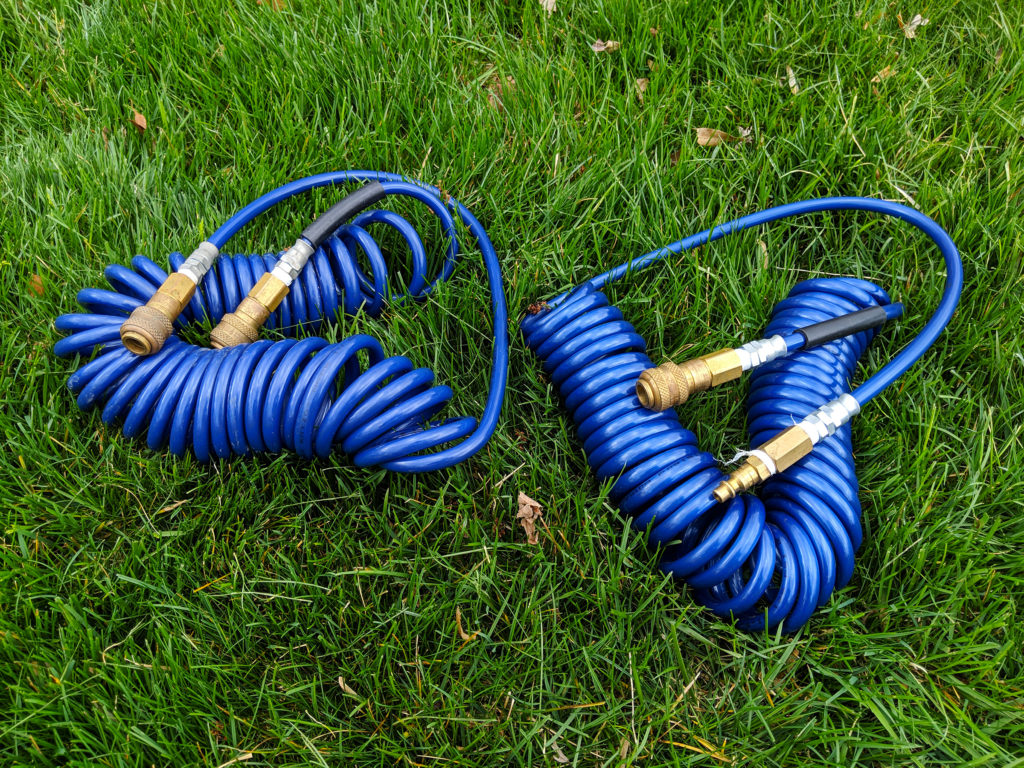
Inflator Improvements
While doing all this I also decided to make a big improvement to the handheld inflator at the end of the hose. Since the original Viair inflator was starting to not work as well due to a sticking trigger I decided to purchase a new inflator. I purchased the Kobalt Inflator with Gauge. The handle assembly seemed of ok quality, but there was another big improvement I wanted. I decided that I wanted a hose on the end that was long enough so I could attach the hose to the tire stem and then stand up while it was in use. I was tired of always having sore knees because the hoses on these things are so short! I also took the opportunity to upgrade the cheap clip-on style chuck to a higher quality brass clip-on chuck.
I used the same 3ft hose that I have on the compressor. This gives me plenty of length to get to the valve stem even if it’s at the 6 o’clock position, and I can stand! The clip-on chuck was also amazing and a great upgrade other the thread-on type that came with the Viair inflator. Although this was a fairly low cost inflator ($20 when I bought it) it’s held up well to 2 ½ years of regular use. I recently did start to have a leak in the handle at the trigger but a quick disassembly and cleaning with alcohol and it was back to like new. I’ll also note that I have opted to stick with an analog pressure gauge because I didn’t want to have to worry about the batteries dying on a digital gauge. This has been reliable with no fuss!
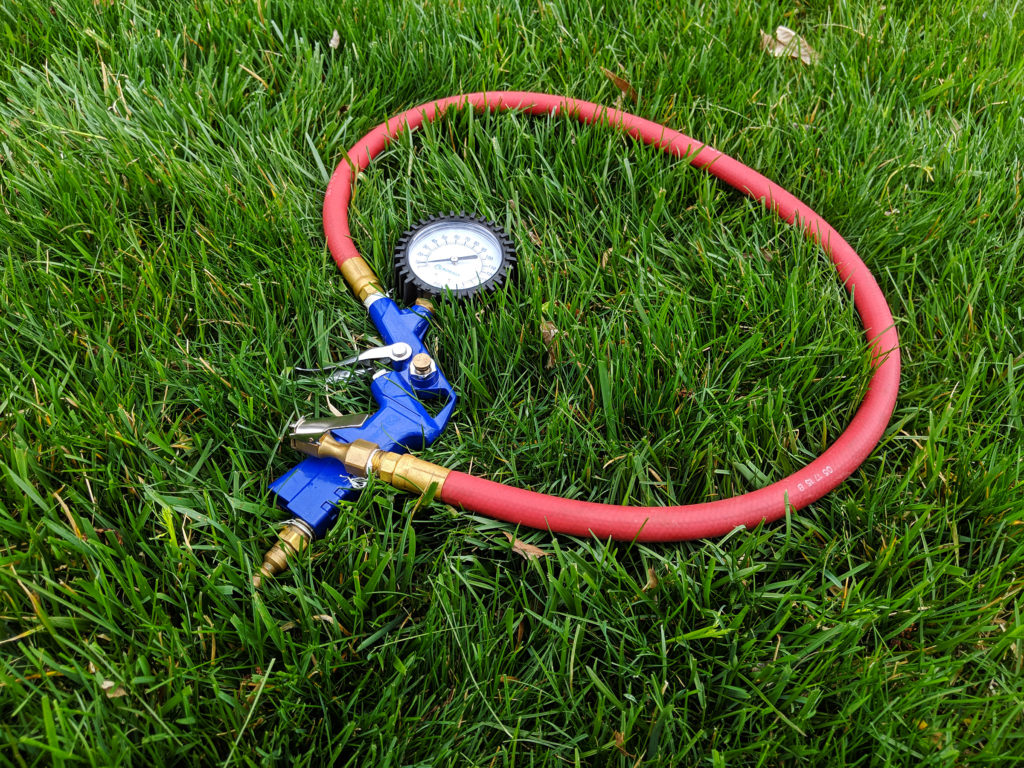
Note About Dixon Quick Disconnects
Note that I used Dixon Quick Disconnects for all my fittings. I strongly prefer the push to connect adapter that Dixon offers to the traditional design where you must pull the sleeve back and then insert the male adapter, then release the sleeve.
That being said, I have had issues with Dixon Industrial fittings mating with non-Dixon Industrial fittings of the same size. Not sure why, they appear to almost match dimensionally, but I have had issues.
As a result all my fittings work well with each other, but you may find that these fittings don’t work with other hoses/attachments without also using Dixon fittings on them. For me it’s worth the small headache since I only connect my equipment to other equipment I own about 99% of the time, but I figured I’d mention it.
Summary
I’ve been using this setup for about 2 ½ years now. Overall it has held up well. The hoses have held up to regular use on about 40 trips total in all kinds of weather from summers near 100F to winter snow wheeling in the teens. The push-to-connect quick disconnects are a great upgrade and I don’t know why more people don’t use them. Finally, the additional hose length on my inflator has been really great. It makes airing the tires up and down using the inflator a breeze and my knees and my wife’s knees are no longer sore after doing this usual chore! Make sure to use teflon tape on all your threaded connections and tighten everything tightly to avoid leaks.
Viair made a great, reliable, compressor. It’s quieter than some of the competition, seems to last, and always works. But with the small improvements I’ve made I like the setup much better. I am working on a method of keeping the compressor cooler overall. If it works out I’ll be sure to share.
Parts List
Air Compressor
- Viair 400P-RV Automatic Air Compressor
- Dixon DCP21B Push-to-Connect Industrial Air Fitting (M-M) (10 pack)
- Tekton 3/8in x 3ft Rubber Air Hose
- WYNNsky 1/4″ NPT 360 Degree Swivel Air Hose Connector (2 pack)
Hose 1
- Plastair 25ft Polyurethane Hose
- Dixon DCB20 Push-to-connect Industrial Air Hose Fitting (F-F) – Need 2
Hose 2
- Plastair 25ft Polyurethane Hose
- Dixon DCB20 Push-to-connect Industrial Air Hose Fitting (F-F)
- Dixon DCP20B Push-to-Connect Industrial Air Hose Fitting (M-F)
Inflator
Disclaimer: I participate in the Amazon Affiliate program. By purchasing items listed on Amazon using the links on this website you are supporting this website. I received no compensation for listing or using any of the products linked to on this page.
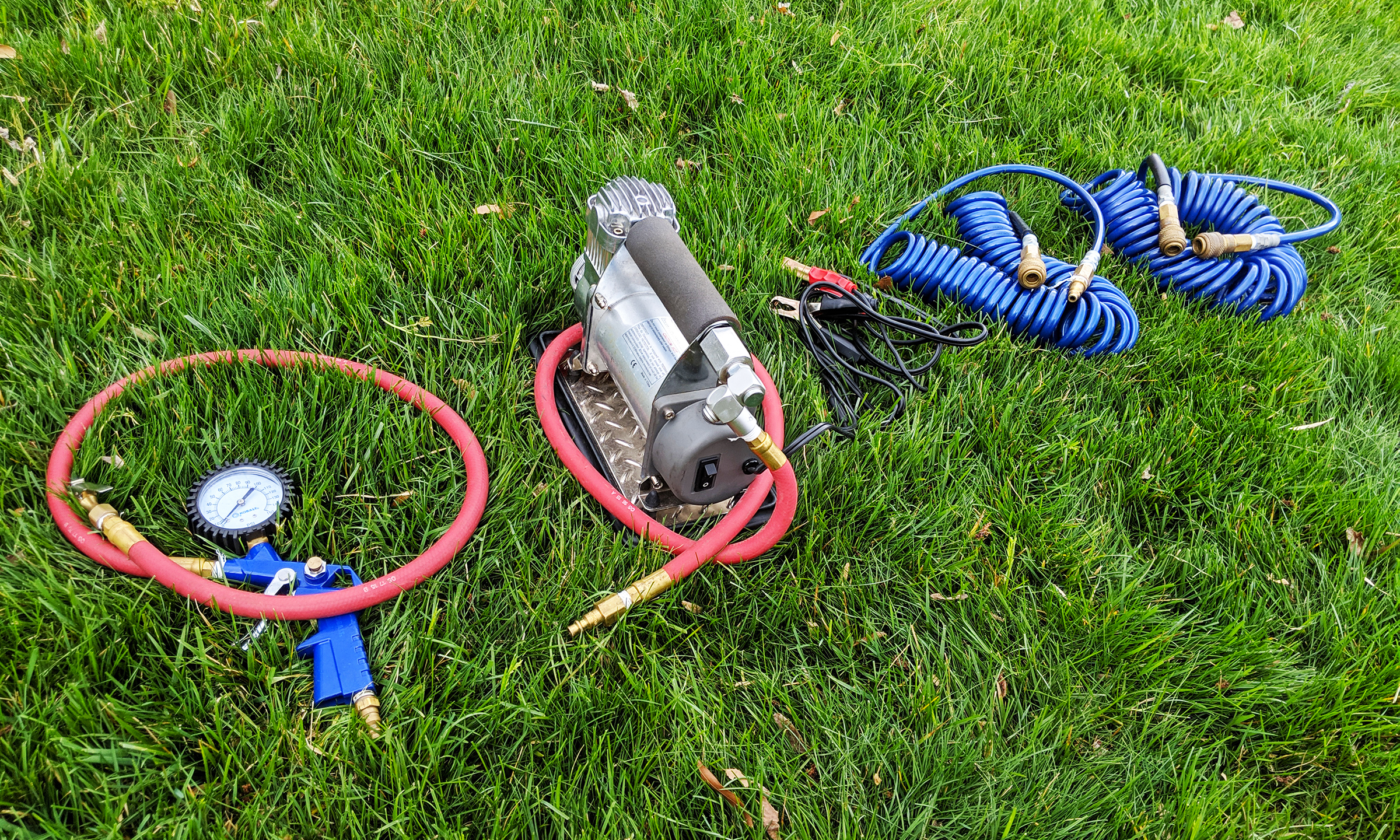
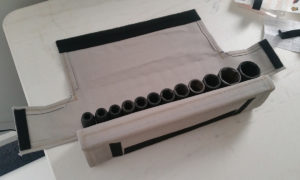

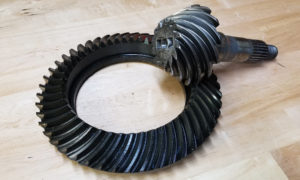
Where did you get the 1/4 GHT to NPT adapter? This is a crucial part!
Not sure where you think there are GHT threads in this setup. Please elaborate. If I recall correctly I think all the hoses and adapters use NPT.
The Viair 300p compressor I bought uses BSP threading (sorry I thought it was GHT), not NPT. I discovered this while trying to install the NPT swivel adapter I bought from Lowe’s per your suggestion. I see on yours there is an extension attached to the compressor air line before the swivel adapter. I assumed that was a GHT to NPT thread adapter. So your unit is NPT?! Dang I wish mine was. I had to buy the correct thread adapter from Amazon just now.
I see what you’re asking about now. Ya, the large hex looking piece that my industrial quick connect goes into was on the compressor from the factory and is threaded for 1/4in NPT. Looking at some pictures this appears to be on the 400P-automatic variant of the compressor, not the 300P and 400P versions. It looks like that part has what I can only assume is a pressure line going back to a feedback device to kill the motor once the line pressure is reached on the automatic version of this compressor. Glad you were able to find an adapter… Read more »